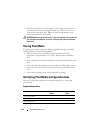
190 Print Media Guidelines
unwrapped, even in the feeder, can contribute to paper curling prior to
printing and cause feeding problems regardless of humidity. When printing
on curled paper, straighten the paper and then insert it into the MPF or PSI.
Smoothness
The degree of paper smoothness directly affects print quality. If the paper is
too rough, the toner does not fuse to the paper properly, resulting in poor
print quality. If the paper is too smooth, it can cause paper feeding problems.
Smoothness between 150 and 250 Sheffield points produces the best print
quality.
Moisture Content
The amount of moisture in the paper affects both print quality and the ability
of the printer to feed the paper properly. Leave the paper in its original
packaging until you are ready to use it. This limits the exposure of the paper
to moisture changes that can degrade its performance.
Grain Direction
Grain refers to the alignment of the paper fibers in a sheet of paper. Grain is
either grain long, running the length of the paper, or grain short, running the
width of the paper. For 60 to 135 g/m
2
(16 to 36 lb bond) paper, grain long
fibers are recommended. For paper heavier than 135 g/m
2
(36 lb bond), grain
short is preferred.
Fiber Content
Most high-quality xerographic paper is made from 100% chemically pulped
wood. Paper containing fibers such as cotton possess characteristics that can
result in degraded paper handling.
Recommended Paper
To ensure the best print quality and feed reliability, use dry 75 g/m
2
(20 lb)
xerographic paper. Business paper designed for general business use also
provide acceptable print quality. Only use paper able to withstand high
temperatures without discoloring, bleeding, or releasing hazardous emissions.
The laser printing process heats paper to high temperatures. Check with the
manufacturer or vendor to determine whether the paper you have chosen is
acceptable for laser printers.


















